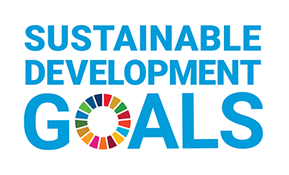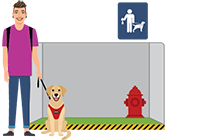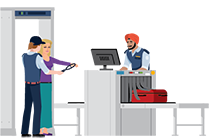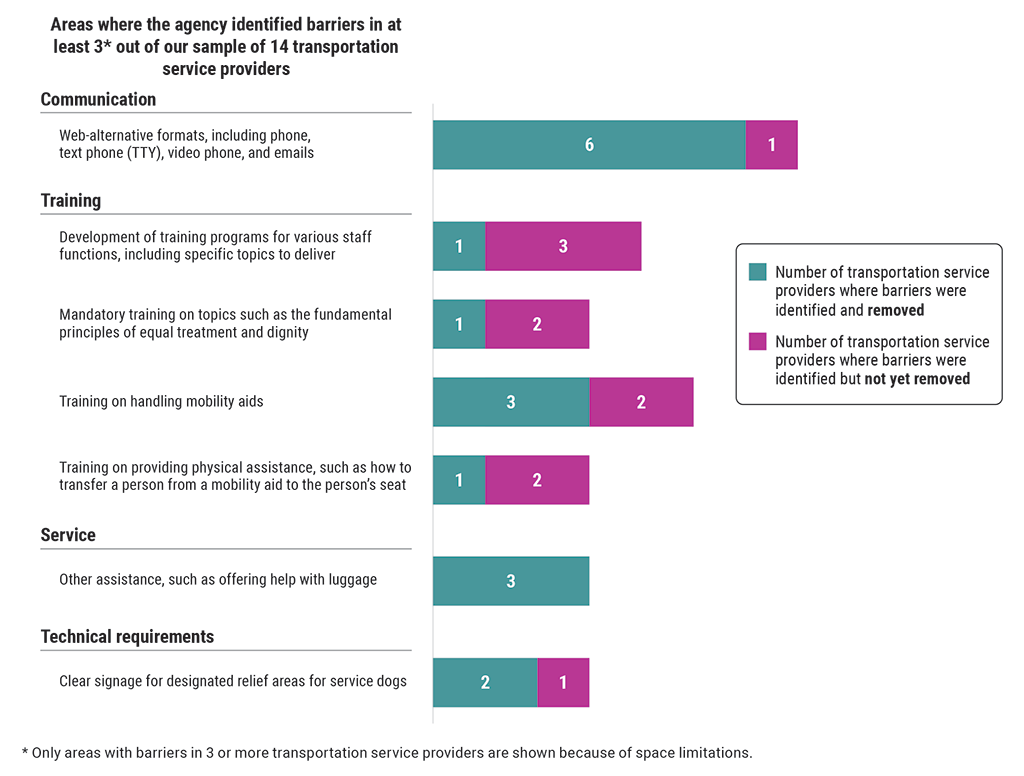2023 Reports 1 to 4 of the Auditor General of Canada to the Parliament of Canada
Report 1—Accessible Transportation for Persons With Disabilities
At a Glance
Overall, VIA Rail, the Canadian Air Transport Security Authority, and the Canadian Transportation Agency took steps toward improving transportation accessibility by identifying, reducing, and preventing some of the barriers faced by persons with disabilities, but more needs to be done. In 2019 and 2020, nearly two thirds of the 2.2 million persons with disabilities who travelled on planes, trains, and other federally regulated modes of transportation faced a barrier.
While VIA Rail and the Canadian Air Transport Security Authority—as transportation service providers—consulted with persons with disabilities to gather feedback on projects such as accessibility plans and the design of VIA Rail’s new fleet, some ongoing issues that persons with disabilities regularly face remained. For example, websites for planning and booking trips were not fully accessible despite this being one of the most frequently experienced barriers in transportation for persons with disabilities. We also found that staff and management did not always complete their accessibility training on time, which can affect the service persons with disabilities receive.
As the organization responsible for overseeing the accessibility regulations for the transportation industry, the Canadian Transportation Agency identified accessibility barriers through its inspections and worked with transportation service providers to remove some of the barriers. However, inspections looked at how the services were designed but did not test the actual service delivery. Also, just 4 full-time-equivalent employees were responsible for monitoring and enforcing more than 450 provisions for more than 130 transportation service providers. As a result, some of the barriers could remain, and new ones could be introduced.
VIA Rail’s, the Canadian Air Transport Security Authority’s, and the Canadian Transportation Agency’s efforts to improve accessibility would be enhanced if the organizations went beyond resolving individual complaints and more deeply analyzed complaint data to better understand the day-to-day experiences of travellers with disabilities. The Canadian Transportation Agency has very limited authority to request complaint data from the transportation service providers.
Key facts and findings
- VIA Rail and the Canadian Air Transport Security Authority took steps toward engaging with persons with disabilities for specific activities. However, as envisioned in federal accessibility legislation and related regulations, persons with disabilities should have been consulted more broadly—such as on teaching methods for accessibility training.
- From 2017 to 2022, the Canadian Air Transport Security Authority categorized 83 complaints under persons with disabilities. However, more than 1,000 complaints, many of which were made by or on behalf of persons with disabilities, included terms related to a disability but were instead categorized by the operational nature of the complaint. Data about complaints made by persons with disabilities was not leveraged to identify and prevent barriers to accessible travel.
- In its oversight role, the Canadian Transportation Agency had insufficient tools and enforcement staff to address all the barriers. Just 4 full-time-equivalent employees at the agency were responsible for monitoring more than 130 transportation service providers and enforcing the Accessible Transportation for Persons With Disabilities Regulations, which contain more than 450 enforceable provisions. The agency looked at how services were designed, in accordance with the regulations—not the actual delivery of services.
- The percentage of managers and executives who did not complete their mandatory accessibility training on time was 39% at VIA Rail and 31% at the Canadian Air Transport Security Authority. An additional 17% of managers and executives at VIA Rail did not complete the training at all. However, 80% of client-service staff at VIA Rail and 78% of third-party screening personnel at the Canadian Air Transport Security Authority completed their training on time.
- According to Statistics Canada, 1 in 5 Canadians aged 15 and over have 1 or more disabilities that could limit their participation in everyday activities. Of the 2.2 million persons with disabilities who used federally regulated transportation in 2019 and 2020, 63% faced a barrier.
Why we did this audit
- All Canadians have the right to fully participate in society, regardless of their abilities.
- The federal government has committed, nationally and internationally, to leading by reducing barriers to transportation for persons with disabilities. This commitment aligns with the government’s commitment to the United Nations’ Sustainable Development Goals, which pledge to leave no one behind.
- Engaging persons with disabilities and their representative groups is a key part of shifting attitudes and eliminating stigma.
- Monitoring and enforcing Accessible Transportation for Persons With Disabilities Regulations help eliminate preventable barriers.
Highlights of our recommendations
- VIA Rail and the Canadian Air Transport Security Authority should ensure that their online content meets web accessibility standards so that travellers with disabilities can easily find the information they need.
- The Canadian Transportation Agency should increase its capacity to identify accessibility barriers and enforce their removal by
- implementing additional oversight approaches, such as direct observations of available services to capture the actual experience of travellers with disabilities
- reviewing and adjusting its enforcement staffing level
Please see the full report to read our complete findings, analysis, recommendations and the audited organizations’ responses.


As the regulator, the Canadian Transportation Agency is responsible for overseeing and monitoring the accessibility regulations for the transportation industry under federal jurisdiction. With this role, the agency contributes to the United Nations’ Sustainable Development Goal 10 (Reduced Inequalities) and target 10.3, which is to ensure equal opportunity and reduce inequalities of outcome.
At the time of our audit, the agency was responsible for monitoring compliance with the Accessible Transportation for Persons With Disabilities Regulations, which contain more than 450 enforceable provisions for more than 130 transportation service providers. The agency was also responsible for an increasing number of provisions and regulations that were outside the scope of this audit.
Visit our Sustainable Development page to learn more about sustainable development and the Office of the Auditor General of CanadaOAG.
Exhibit highlights
The Accessible Transportation for Persons With Disabilities Regulations require federally regulated transportation service providers to remove barriers
| Developed under the Canada Transportation Act, the Accessible Transportation for Persons With Disabilities Regulations require transportation service providers to make travel more accessible, including the following: | Examples of meeting the requirement |
|---|---|
| Meet communication needs by following accessibility standards for online information. | 
Alfred, who is visually impaired, can book his ticket online using a screen reader. |
| Educate workers and decision makers to develop awareness and increase capacity related to accessibility. Training material content must be developed in consultation with persons with disabilities and meet specific requirements. | 
Bianca, who travels with a sign language interpreter, is addressed directly and with dignity when she interacts with airport workers. |
| Provide accessibility services, such as buffer zones to protect against exposure to allergens. | 
Chayton’s train seat is located far away from potential sources of his severe allergy, and passengers in that area are instructed to avoid products that could trigger his allergy. |
| Make aircraft, trains, ferries, buses, and terminals accessible by complying with specific technical requirements. | 
Dani’s seizure alert dog has a conveniently located service dog relief area at terminals when needed. |
| Make security screening services more accessible by having knowledgeable security officers at terminals to help travellers with disabilities. | 
Elise can use a special faster line when she goes through airport security to reduce her severe pain when waiting in line. |
Source: Based on requirements from the Accessible Transportation for Persons With Disabilities Regulations
Transportation service providers had to make their online information accessible by meeting web accessibility standards that cover 4 principles
Perceivable
The content can be perceived by users, no matter what senses they rely on. |
Understandable
The content is clear and concise, and users can explore it at their own pace. |
Operable
Users can easily navigate, find content, and determine where they are. |
Robust
Assistive technologies can reliably interpret content. |
Source: Adapted from the Web Content Accessibility Guidelines 2.0, published by the World Wide Web Consortium
A number of management personnel at VIA Rail and the Canadian Air Transport Security Authority who were employed at any time between June 2020 and June 2022 did not complete required accessibility training on time

Source: Based on information provided by VIA Rail and the Canadian Air Transport Security Authority
Text version
These 4 half pie charts show the number of management and other personnel at VIA Rail and the Canadian Air Transport Security Authority who completed accessibility training on time, completed it late, or did not complete it.
For managers and executives at VIA Rail, 10 (or 44%) completed the training on time, 9 (or 39%) completed it late, and 4 (or 17%) did not complete it.
However, for client‑service staff at VIA Rail, 25 (or 80%) completed the training on time, 3 (or 10%) completed it late, and 3 (or 10%) did not complete it.
For managers and executives at the Canadian Air Transport Security Authority, 11 (or 69%) completed the training on time and 5 (or 31%) completed it late. In 2021, the Canadian Air Transport Security Authority committed to the Canadian Transportation Agency to train all managers and executives subject to the Accessible Transportation for Persons With Disabilities Regulations by 31 March 2022. Training completed before this date was considered on time.
For third‑party screening personnel at the Canadian Air Transport Security Authority, 32 (or 78%) completed the training on time, 8 (or 20%) completed it late, and 1 (or 2%) did not complete it.
The Canadian Transportation Agency identified barriers for travellers with disabilities

Source: Based on data from the Canadian Transportation Agency’s inspection files
Text version
This bar chart shows the barriers for travellers with disabilities identified by the Canadian Transportation Agency. The chart shows areas where the agency identified barriers in at least 3 out of our sample of 14 transportation service providers. Only areas with barriers in 3 or more transportation service providers are shown because of space limitations.
The first area was communication, under which 1 type of barrier was identified by the agency. This type of barrier was web‑alternative formats, including phone, text phone (TTY), video phone, and emails. The barrier was identified and removed in 6 transportation service providers, but it was identified and not yet removed in 1 additional transportation service provider.
The next area was training, under which 4 types of barriers were identified by the agency:
- The first barrier under this area was the development of training programs for various staff functions, including specific topics to deliver. This barrier was identified and removed in 1 transportation service provider, but it was identified and not yet removed in 3 additional transportation service providers.
- The second type of barrier under this area was mandatory training on topics such as the fundamental principles of equal treatment and dignity. This barrier was identified and removed in 1 transportation service provider, but it was identified and not yet removed in 2 additional transportation service providers.
- The third type of barrier under this area was training on handling mobility aids. This barrier was identified and removed in 3 transportation service providers, but it was identified and not yet removed in 2 additional transportation service providers.
- The fourth type of barrier under this area was training on providing physical assistance, such as how to transfer a person from a mobility aid to the person’s seat. This barrier was identified and removed in 1 transportation service provider, but it was identified and not yet removed in 2 additional transportation service providers.
The next area was service, under which 1 type of barrier was identified by the agency. This type of barrier was other assistance, such as offering help with luggage. The barrier was identified and removed in 3 transportation service providers. There were no additional transportation service providers where the barrier was identified and not yet removed.
The last area was technical requirements, under which 1 type of barrier was identified by the agency. This type of barrier was clear signage for designated relief areas for service dogs. The barrier was identified and removed in 2 transportation service providers, but it was identified and not yet removed in 1 additional transportation service provider.
Infographic

Text version
Accessible Transportation for Persons With Disabilities
Persons with disabilities regularly face barriers when travelling
1 in 5 Canadians aged 15 or older have 1 or more disabilities that could limit their participation in activities, such as travelling.
63% of the 2.2 million persons with disabilities who used federally regulated transportation in 2019 and 2020 faced a barrier. A doughnut graph shows that 63% of people faced a barrier and 37% of people did not. Source: Data from Statistics Canada.
Example scenarios
Barriers are present
Alfred, who is visually impaired, cannot book his travel ticket online. His screen reader won’t work because the website does not meet accessibility standards.
Four images show the process that Alfred uses to book a ticket.
In the first image, Alfred sits in front of a laptop and frowns. Alfred will not be able to book his trip on his own.
In the second image, he is on the phone. He will need to call a booking agent or ask someone for help to book it online.
In the third image, he sits beside a smiling woman, who is helping him book a ticket using the laptop.
In the fourth image, Alfred holds up his travel ticket.
Barriers are reduced
Bianca travels with a sign language interpreter. When airport workers interact with Bianca, they usually remember to speak with her directly. Talking to the interpreter like Bianca isn't there is disrespectful.
The first image under the example shows an airline staff member talking directly with Bianca. A man stands between them and signs.
Timely and reoccurring training on accessibility for management and workers improves services and experiences for travellers with disabilities. A second image shows a classroom with a woman teaching at the front. There are 5 airline staff members in the classroom—one of whom is the same staff member who was talking with Bianca.
Barriers are removed
Dani travels with their seizure alert dog, Stella. Dani noticed that the number of service dog relief areas available in terminals has increased. This makes it easier for Dani to travel with Stella.
In the image, Dani stands beside Stella, a service dog, in front of a dog relief area that has a grass-like floor and an artificial fire hydrant in the corner.
Monitoring and enforcing accessible transportation regulations
A flow chart shows that the equivalent of just 4 full-time employees are responsible for monitoring and enforcement of more than 130 transportation service providers and more than 450 enforceable provisions.
How to achieve barrier-free travel
To achieve barrier-free travel, accessibility needs to be improved through continuous consultations with persons with disabilities, more direct inspections of carriers and terminals, and appropriate staff training.
An image shows a diverse group of people smiling: a man who is missing a leg and leaning on a cane, a woman holding the leash attached to a service dog, a woman using a walker, a woman wearing a mask, a man using a wheelchair, a man standing in the back, a woman wearing dark glasses and holding a white cane, a woman waving with her prosthetic arm, and a child signing.
Related information
Entities
Tabling date
- 27 March 2023




